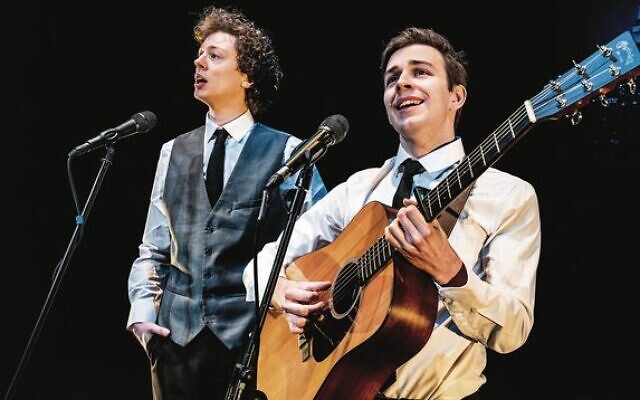From childhood to stardom
They had a troubled relationship and very public artistic disagreements before their break-up in 1970, but Simon and Garfunkel were about so much more than their differences, and their history goes way back to their primary school days. Jessica Abelsohn explores the duo's history and partnership.
Simon and Garfunkel were one of the best-selling music groups in the ’60s with some pretty big hits including The Sound of Silence, Mrs Robinson and Bridge over Troubled Water. As the story goes, though, they met way back in PS 164 in Kew Gardens Hills.
Paul Simon and Arthur (Art) Garfunkel were born into Jewish families in New York City, less than one month apart. According to both, their families’ Jewish roots instilled in them a strong sense of cultural identity and values, which would later influence their music.
Crossing paths in primary school, Paul and Art soon discovered their shared passion for music and began singing together, honing their harmonies and songwriting skills. In addition to the secular music they loved, they also drew inspiration from the rich Jewish musical tradition, incorporating elements of Jewish melodies and themes into some of their early compositions.
According to Across America, Garfunkel’s live album, his love of singing started in year 1. “When we were lined up in size order, and after everyone else had left, I’d stay behind and enjoy the echo sound of the stairwell tiles and sing Unchained Melody and You’ll Never Walk Alone, learning to love this goosebumps song from the tender age of five,” he said.
For Simon, his childhood was filled with music and baseball. Musician Donald Fagen described it as a “certain kind of New York Jew”.
“I think it has to do with the parents. The parents are either immigrants or first-generation Americans who felt like outsiders, and assimilation was the key thought,” Fagen said. “They gravitated to black music and baseball, looking for an alternative culture.” It was a sentiment that Simon largely agreed with.
The pair met when they were 10, performing in a school production of Alice in Wonderland. By the age of 13, they had formed a duo, performing Simon’s first song The Girl for Me.
According to legend, Simon’s father wrote the words and chords on a piece of paper for the boys to use. This became the first officially copyrighted Simon and Garfunkel song.
But Simon and Garfunkel’s rise to fame was a gradual journey. In 1957, under the name Tom and Jerry, they recorded their first single, Hey Schoolgirl, which reached moderate success on the charts. Despite this initial taste of recognition, they chose to focus on their education, attending separate colleges and briefly parting ways.
Fate, however, had other plans. In the early 1960s, they reunited and signed with Columbia Records.
In 1964, they released their debut studio album, Wednesday Morning, 3 A.M. Though the album received little attention initially, the song The Sound of Silence caught the attention of radio DJs, leading to its unexpected resurgence. The hauntingly beautiful melody and introspective lyrics struck a chord with listeners, propelling the song to the top of the charts and launching Simon and Garfunkel into the spotlight.
By the time Mrs Robinson was featured in the 1967 film The Graduate, the pair were well on their way to stardom. In fact, their third album, Bookends, topped the Billboard 200 chart.
But their relationship wasn’t smooth sailing. Behind their harmonious performances were underlying tensions and disagreements.
Simon, the primary songwriter of the duo, was known for his perfectionism and desire for creative control. Garfunkel, on the other hand, was celebrated for his angelic voice but sometimes struggled to find his own footing in the shadow of Simon’s songwriting prowess. As their popularity soared, so did the strain on their partnership.
By 1970, the pair had split.
In 1972, Simon and Garfunkel briefly reunited for a charity concert in New York’s Central Park, performing in front of 500,000 fans. The event was a massive success, and it led to a subsequent reunion tour in 1981, followed by another in 2003.
However, old tensions resurfaced and disagreements once again plagued their partnership.
Simon and Garfunkel’s songs have become part of the cultural fabric, resonating with audiences across generations. From the haunting Bridge over Troubled Water to the contemplative The Boxer, their music continues to evoke emotions and inspire new musicians to this day, including William Sharp and Oliver Cave. The duo are portraying Simon and Garfunkel respectively in The Simon & Garfunkel Story.
The production toured Australia in 2018, and following sold-out performances in London’s West End, a worldwide tour and standing ovations at every performance, it will be returning to our shores next week. Both have taken on the personas and mannerisms of Simon and Garfunkel perfectly.
While he didn’t have a relationship with their music before, Cave told The AJN that he can see how their audiences respond so positively to their performances.
“Hopefully it reminds them of times they’ve watched Simon and Garfunkel perform,” he said.
“For those who love the songs, it’s a great reminder of them and for those that don’t know them, we go through the whole story of the band. At any rate, the songs are so good that I think there’s something for everyone.”
Starting from their humble beginnings, The Simon & Garfunkel Story takes you through all the songs and stories that shaped them, the dramatic split, their individual solo careers and ends with a stunning recreation of the legendary 1981 Central Park reunion concert.
With a review like “as close to the real thing as it’s possible to get”, Sharp and Cave are clearly doing something right.
The Simon & Garfunkel Story is at Hamer Hall, Arts Centre Melbourne on Tuesday, August 8. For tickets: thesimonandgarfunkelstory.com


comments